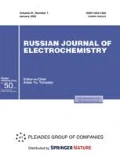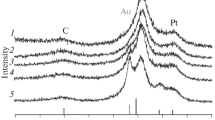Abstract
Platinum-containing bimetallic nanoparticles manifest high functional characteristics as electrocatalysts. To use PtCu/C catalysts in low-temperature fuel cells, it is necessary to minimize selective copper dissolution, as copper cations can pollute the polymer membrane and decrease its proton conductivity. The work determines the composition, measures the electrochemically active surface area, and studies the electrochemical behavior of PtCu/C catalysts containing nanoparticles with a “core–shell” structure in the initial state (as-prepared) and after pretreatment in solutions of different acids. The comparative determination of catalyst activity in an electrochemical cell and their testing in a membrane-electrode assembly of fuel cells showed that pretreated PtCu/C materials with a much better stability as compared to Pt/C were also noninferior to the latter as regards their activity in the oxygen electroreduction reaction.







Similar content being viewed by others
Notes
The term of “weakly bound” copper in this context is not necessarily related to a particular chemical state of individual copper atoms. It only reflects the fact that some fraction of copper atoms passes into the solution in the form of Cu2+ cations, while the rest of them remain in bimetallic nanoparticles.
REFERENCES
Crawley, G., Proton exchange membrane (PEM) fuel cells: opening doors to fuel cell commercialization, Fuel Cell Today, 2006, p. 1.
O’Hayre, R.P., Fuel Cell Fundamentals, 2nd ed., New York, 2009, p. 576.
Kongkanand, A. and Mathias, M.F., The Priority and Challenge of High-Power Performance of Low-Platinum Proton-Exchange Membrane Fuel Cells, J. Phys. Chem. Lett., 2016, vol. 7, p. 1127.
Yaroslavtsev, A.B., Dobrovolsky, Yu.A., Shaglaeva, N.S., Frolova, L.A., Gerasimova, E.V., and Sanginov, E.A., Nanostructured materials for low-temperature fuel cells, Russ. Chem. Rev., 2012, vol. 81, p. 191.
Sui, Sh., Wang, X., Su, Y., Zhou, S., and Riffat, Ch., A comprehensive review of Pt electrocatalysts for the oxygen reduction reaction: Nanostructure, activity, mechanism and carbon support in PEM fuel cells, J. Mater. Chem. A, 2017, vol. 5, p. 1808.
Thompsett, D., Catalysts for the proton exchange membrane fuel cell in Handbook of Fuel Cells.Fundamentals, Technology and Applications, New York, 2003.
Holton, O.T. and Stevenson, J.W., The Role of Platinum in Proton Exchange Membrane Fuel Cells, Platinum Met. Rev., 2013, vol. 57, p. 259.
Banham, D.W.H. and Ye, S., Current Status and Future Development of Catalyst Materials and Catalyst Layers for Proton Exchange Membrane Fuel Cells: An Industrial Perspective, ACS Energy Lett., 2017, vol. 2, p. 628.
Shao, M., Chang, Q., Dodelet, J-P., and Chenitz, R., Recent Advances in Electrocatalysts for Oxygen Reduction Reaction, Chem. Rev., 2016, vol. 116, p. 3594.
Lv, H., Li, D., Strmcnik, D., Paulikas, A.P., Markovic, N.M., and Stamenkovic, V.R., Recent advances in the design of tailored nanomaterials for efficient oxygen reduction reaction, Nano Energy, 2016, vol. 29, p. 149.
Wang, J., Li, B., Yang, D., Lv, H., Zhang, C., Preparation optimization and single cell application of PtNi/C octahedral catalyst with enhanced ORR performance, Electrochimica Acta, 2018, vol. 288, p. 126.
Litster, S., PEM fuel cell electrodes, J. Power Sources, 2004, vol. 130, p. 61.
Gasteiger, H.A. Fuel cell related catalysis in Handbook of heterogeneous catalysis, New York, 2008, p. 3081.
Hoogers, G., Fuel Cell Technology Handbook, CRC Press LLC, 2003, p. 335.
Xu, Zh., Zhang, H., Liu, S., Zhang, B., Zhong, H., and Su, D., Facile synthesis of supported Pt–Cu nanoparticles with surface enriched Pt as highly active cathode catalyst for proton exchange membrane fuel cells, Int. J. Hydrogen Energy, 2012, vol. 37, p. 17978.
Guterman, V.E., Lastovina, T.A., Belenov, S.V., et al. PtM/C (M = Ni, Cu, or Ag) Electrocatalysts: Effects of Alloying Components on Morphology and Electrochemically Active Surface Areas, J. Solid State Electrochem., 2014, vol. 18, p. 1307.
Singh, R.N., Awasthi, R., and Sharma, C.S., Review: An overview of recent development of platinum based cathode materials for direct methanol fuel cells, Int. J. Electrochem. Sci., 2014, vol. 9, p. 5607.
Neergat, M. and Rahul, R., Unsupported Cu–Pt Core–Shell Nanoparticles: Oxygen Reduction Reaction (ORR) Catalyst with Better Activity and Reduced Precious Metal Content, J. Electrochem. Soc., 2012, vol. 159, p. F234.
Antolini, E., Platinum-based ternary catalysts for low temperature fuel cells Part II. Electrochemical properties, Appl. Catal., B, 2007, vol. 87, p. 337.
Stamenkovic, V.R., Mun, B.S., Arenz, M., May-rhofer, K.J.J., Lucas, C.A., Wang, G., Ross P.N., Markovic, N.M., Trends in electrocatalysis on extended and nanoscale Pt-bimetallic alloy surfaces, Nat. Mater., 2007, vol. 6, p. 241.
Jung, N., Chung, D.Y., Ryu, J., Yoo, S.J., and Sung, Y., Pt-based nanoarchitecture and catalyst design for fuel cell applications, Nano Today, 2014, vol. 9, p. 433.
Paulus, U.A., Wokaun, A., and Scherer, G.G., Oxygen Reduction on Carbon-Supported Pt–Ni and Pt–Co Alloy Catalysts, J. Phys. Chem. B, 2002, vol. 106, p. 4181.
Stamenkovic, V., Schmidt, T.J., Ross, P.N., and Markovic, N.M., Surface Composition Effects in Electrocatalysis: Kinetics of Oxygen Reduction on Well-Defined Pt3Ni and Pt3Co Alloy Surfaces, J. Phys. Chem. B, 2002, vol. 106, p. 11970.
Travitsky, N., Ripenbein, T., Golodnitsky, D., Rosenberg, Y., Burshtei, L., and Peled, E., Pt-, PtNi- and PtCo-supported catalysts for oxygen reduction in PEM fuel cells, J. Power Sources, 2006, vol. 161, p. 782.
Strasser, P., Free Electrons to Molecular Bonds and Back: Closing the Energetic Oxygen Reduction (ORR)−Oxygen Evolution (OER) Cycle Using Core–Shell Nanoelectrocatalysts, Acc. Chem. Res., 2016, vol. 49, p. 2658.
Mani, P., Srivastava, R., and Strasser, P., Dealloyed binary PtM3 (M = Cu Co, Ni) and ternary PtNi3M (M = Cu, Co, Fe, Cr), J. Power Sources, 2011, vol. 196, p. 666.
Oezaslan, M. and Strasser, P., Activity of dealloyed PtCo3 and PtCu3 nanoparticle electrocatalyst for oxygen reduction reaction in polymer electrolyte membrane fuel cell, J. Power Sources, 2011, vol. 196, p. 5240.
Nguyen, M.T., Wakabayashi, R.H., Yang, M., Abruna, H.D., and Di Salvo, F.J., Synthesis of carbon supported ordered tetragonal pseudo-ternary Pt2M'M'' (M = Fe Co, Ni) nanoparticles and their activity for oxygen reduction reaction, J. Power Sources, 2015, vol. 280, p. 459.
Hyun, K., Lee, J.H., Yoon, C.W., and Kwon, Y., The effect of platinum based bimetallic electrocatalysts on oxygen reduction reaction of proton exchange membrane fuel cells, Int. J. Electrochem. Sci., 2013, vol. 8, p. 11752.
Gasteiger, H.A., Kocha, Sh.S., Sompalli, B., and Wagner, F.T., Activity benchmarks and requirements for Pt, Pt-alloy, and non-Pt oxygen reduction catalysts for PEMFCs, Appl. Catal., B, 2005, vol. 56, p. 9.
Oezaslan, M., Hasche, F., and Strasser, P., PtCu3, PtCu and Pt3Cu alloy nanoparticle electrocatalysts for oxygen reduction reaction in alkaline and acidic media, J. Electrochem. Soc., 2012, vol. 159, p. B444.
Neyerlin, K.C., Srivastava, R., Yu, Ch., and Strasser, P., Electrochemical activity and stability of dealloyed Pt–Cu and Pt–Cu–Co electrocatalysts for the oxygen reduction reaction (ORR), J. Power Sources, 2009, vol. 186, p. 261.
Antolini, E., Alloy intermetallic compounds: Effect of the ordering on the electrocatalytic activity for oxygen reduction and the stability of low temperature fuel cell catalysts, Applied Catal., B, 2017, vol. 217, p. 201.
Sarkar, A. and Manthiram, A., Synthesis of Pt@Cu Core–Shell Nanoparticles by Galvanic Displacement of Cu by Pt4+ Ions and Their Application as Electrocatalysts for Oxygen Reduction Reaction in Fuel Cells, J. Phys. Chem. C, 2010, vol. 114, p. 4725.
Guterman, V.E., Belenov, S.V., Alekseenko, A.A., Tabachkova, N.Yu., and Volochaev, V.A., The relationship between activity and stability of deposited platinum-carbon electrocatalysts, Russ. J. Electrochem., 2017, vol. 53, p. 531.
Zhu, H., Li, X., and Wang, F., Synthesis and characterization of Cu@Pt/C core–shell structured catalysts for proton exchange membrane fuel cell, Int. J. Hydrogen Energy, 2011, vol. 36, p. 9151.
Yu, Z., Zhang, J., and Liu, Z., Comparison between Dealloyed PtCo3 and PtCu3 Cathode Catalysts for Proton Exchange Membrane Fuel Cells, J. Phys. Chem. C, 2012, vol. 116, p. 19877.
Koh, S., Toney, M.F., and Strasser, P., Activity–stability relationships of ordered and disordered alloy phases of Pt3Co electrocatalysts for the oxygen reduction reaction (ORR), Electrochim. Acta, 2007, vol. 52, p. 2765.
Stamenkovic, V.R., Mun, S.B., Mayrhofer, K.J.J. Ross, Ph.N., and Markovic, N.M., Effect of surface composition on electronic structure, stability, and electrocatalytic properties of Pt-transition metal alloys: Pt‑skin versus Pt-skeleton surfaces, J. Am. Chem. Soc., 2006, vol. 128, p. 8813.
Oezaslan, M., Hasché, F., and Strasser, P., Pt-based core–shell catalyst architectures for oxygen fuel cell electrodes, J. Phys. Chem. Lett., 2013, vol. 4, p. 3273.
Kuhl, S. and Strasser, P. Oxygen Electrocatalysis on Dealloyed Pt Nanocatalysts, Top Catal., 2016, vol. 59, p. 1628.
Alekseenko, A.A., Belenov, S.V., Men’shchikov, V.S., and Guterman, V.E., Pt(Cu)/C Electrocatalysts with Low Platinum Content, Russ. J. Electrochem., 2018, vol. 54, p. 415.
Alekseenko, A.A., Guterman, V.E., Belenov, S.V., Menshikov, V.S., Tabachkova, N.Yu., Safronenko, O.I., and Moguchikh, E.A., Pt/C electrocatalysts based on the nanoparticles with the gradient structure, Int. J. Hydrogen Energy, 2018, vol. 43, p. 3676.
Volochaev, V.A., Belenov, S.V., Alekseenko, A.A., and Guterman, V.E., On the possibilities of recognizing the architecture of binary Pt–M nanoparticles, Nanotechnol. Russ., 2017, vol. 12, nos. 5–6, p. 227.
Kirakosyan, S.A., Alekseenko, A.A., Guterman, V.E., Volochaev, V.A., and Tabachkova, N.Yu., Effect of co atmosphere on morphology and electrochemically active surface area in the synthesis of Pt/C and PtAg/C electrocatalysts, Nanotechnol. Russ., 2016, vol. 11, p. 287.
Shinozaki, K., Zack, J.W., Pylypenko, S., Pivovar, B.S., and Kocha, S.S., Oxygen reduction reaction measurements on platinum electrocatalysts utilizing rotating disk electrode technique: II. Influence of ink formulation, catalyst layer uniformity and thickness, J. Electrochem. Soc., 2015, vol. 162, p. F1384.
Gusev, A.I., Nanomaterialy, nanostruktury, nanotekhnologii (Nanomaterials, Nanostructures, Nanotechnologies), Moscow: FIZMATLIT, 2009.
Guterman, V.E., Belenov, S.V., Krikov, V.V., Vysochina, L.L., Yohannes, W., Tabachkova, N.Yu., and Balakshina, E.N., Reasons for the differences in the kinetics of thermal oxidation of Pt/C nanostructured materials, J. Phys. Chem., C, 2014, vol. 118, p. 23835.
Leontyev, I.N., Leontyeva, D.V., Kuriganova, A.B., Popov, Y.V., Maslova, O.A., Glebova, N.V., and Smirnova, N.V., Characterization of the electrocatalytic activity of carbon-supported platinum-based catalysts by thermal gravimetric analysis, Mendeleev Commun., 2015, vol. 25, p. 468.
Van der Vliet, D., Strmcnik, D.S., Wang, C., Stamenkovic, V.R., Markovic, N.M., and Koper, M.T.M., On the importance of correcting for the uncompensated Ohmic resistance in model experiments of the oxygen reduction reaction, J. Electroanal. Chem., 2010, vol. 647, p. 29.
Wang, Y., Zhou, H., Sun, P., and Chen, T., Exceptional methanol electro-oxidation activity by bimetallic concave and dendritic Pt–Cu nanocrystals catalysts, J. Power Sources, 2014, vol. 245, p. 663.
Moguchikh, E.A., Alekseenko, A.A., Guterman, V.E., Novikovsky, N.M., Tabachkova, N.Yu., and Menshchikov, V.S., Effect of the Composition and Structure of Pt(Cu)/C Electrocatalysts on Their Stability under Different Stress Test Conditions, Russ. J. Electrochem., 2018, vol. 54, p. 979.
ACKNOWLEDGMENTS
The authors are grateful to the Center for Collective Usage of International Research Center of South Federal University and senior researcher T.A. Lastovin for help in thermogravimetric studies.
Funding
The work is supported by the Russian Scientific Foundation (project no. 16-19-10115). The part of work carried out by Gerasimova E.V. was performed in accordance with the state task, state registration no. АААА-19-119061890019-5.
Author information
Authors and Affiliations
Corresponding author
Ethics declarations
The authors declare the absence of any conflict of interest.
Additional information
Translated by M. Ehrenburg
Rights and permissions
About this article
Cite this article
Kirakosyan, S.A., Alekseenko, A.A., Guterman, V.E. et al. De-Alloyed PtCu/C Catalysts of Oxygen Electroreduction. Russ J Electrochem 55, 1258–1268 (2019). https://doi.org/10.1134/S1023193519120085
Received:
Revised:
Accepted:
Published:
Issue Date:
DOI: https://doi.org/10.1134/S1023193519120085



